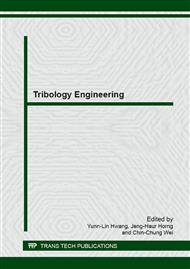[1]
O. Reynolds: On the theory of lubrication and its application to Mr. Beauchamp Tower's experiments, including an experimental determination of the viscosity of olive oil. Philosophical Transactions of the Royal Society of London, vol. 177 (1886), pp.157-234.
DOI: 10.1098/rstl.1886.0005
Google Scholar
[2]
A. I. Petrusevich: Fundamental conclusions from the contact-hydrodynamic theory of lubrication. Izv. Akad. Nauk. SSSR (OTN), vol. 2 (1951), pp.209-223.
Google Scholar
[3]
D. Dowson and G. R. Higginson: A numerical solution to the elasto-hydrodynamic problem. Journal of Mechanical Engineering Science, vol. 1 (1959), pp.6-15.
DOI: 10.1243/jmes_jour_1959_001_004_02
Google Scholar
[4]
H. Okamura: A contribution to the numerical analysis of isothermal elastohydrodynamic lubrication. Proc. 9th Leeds-Lyon Symp. on Tribology, (1983), pp.313-320.
DOI: 10.1016/b978-0-408-22161-0.50048-2
Google Scholar
[5]
B. J. Hamrock and D. Dowson: Isothermal elastohydrodynamic lubrication of point contacts, Part 1- Theoretical formulation. Journal of tribology -Transactions of the ASME, vol. 98 (1976), pp.223-229.
DOI: 10.1115/1.3452801
Google Scholar
[6]
A. A. Lubrecht, T. N. W.E., and R. Bosma: Multigrid, an alternative method of solution for two-dimensional elastohydrodynamically lubricated point contact calculations. Trans. ASME. Journal of Tribology, vol. 109 (1987), pp.437-443.
DOI: 10.1115/1.3261467
Google Scholar
[7]
N. Patir and H. S. Cheng: An Average Flow Model for Determining Effects of Three-Dimensional Roughness on Partial Hydrodynamic Lubrication. ASME, Journal of Lubrication Technology, vol. 100 (1978), pp.12-17.
DOI: 10.1115/1.3453103
Google Scholar
[8]
C. H. Venner and W. E. Ten Napel: Surface Roughness Effects in an EHL Line Contact. ASME, Journal of Tribology, vol. 114 (1992), pp.616-622.
DOI: 10.1115/1.2920926
Google Scholar
[9]
T. Almqvist and R. Larsson: The Navier-Stokes approach for thermal EHL line contact solutions. Tribology International, vol. 35 (2002), pp.163-170.
DOI: 10.1016/s0301-679x(01)00112-8
Google Scholar
[10]
M. Hartinger, M. L. Dumont, S. Ioannides, D. Gosman, and H. Spikes: CFD modeling of a thermal and shear-thinning elastohydrodynamic line contact. Journal of Tribology, vol. 130 (2008), pp.179-180.
DOI: 10.1115/1.2958077
Google Scholar
[11]
S. Gao and S. Srirattayawong: CFD Prediction of the Effects of Surface Roughness on Elastohydrodynamic Lubrication under Rolling/Sliding Conditions. Applied Mechanics and Materials, vol. 184 (2012), pp.86-89.
DOI: 10.4028/www.scientific.net/amm.184-185.86
Google Scholar
[12]
K. L. Johnson and J. L. Tevaarwerk: The shear behaviour of elastohydrodynamic oil films. Proc. R. Soc. London, vol. 356 (1977), pp.215-236.
Google Scholar
[13]
A.K. Singhal, M.M. Athavale, L. Huiying, L. Jiang: Mathematical bases and validation of the full cavitation model. Journal Fluids Engineering, vol. 124 (2002), pp.617-624.
DOI: 10.1115/1.1486223
Google Scholar


